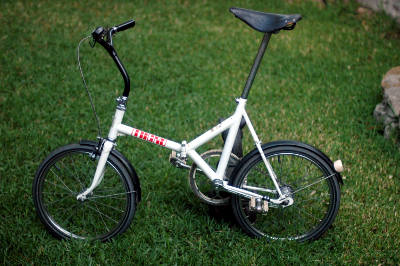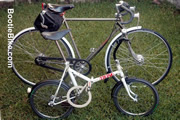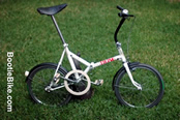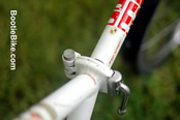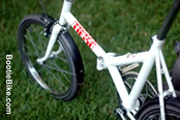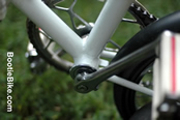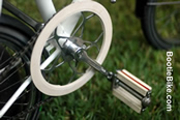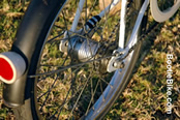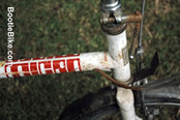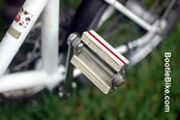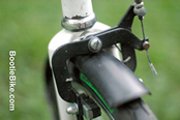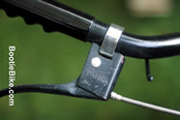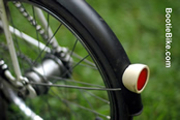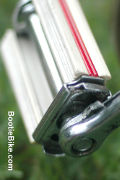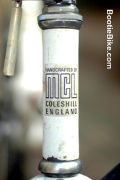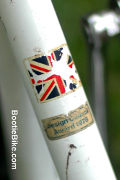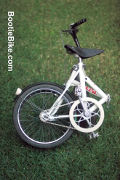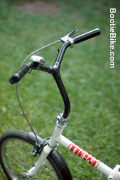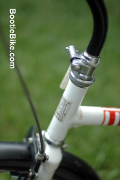1970s Micro portable
A Bickerton challenger
The Micro is a tiny, folding portable bike produced in Coleshill, Warwickshire, UK in the latter half of the 1970s. At that time the original lightweight portable bike, the Bickerton, still had no serious rivals, something the Micro people thought they could change.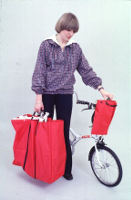
The Micro (not to be confused with the Swedish 'Microbike' from the late 80s) was designed by Peter Radnall, a well known component manufacturer. As the 'Micro' name suggests, the folded bike was meant to be small – small enough to carry anywhere, even on crowded buses and trains. And the best way to achieve that was to start with a bike that was already small in its unfolded state.
In designing the frame, Radnall opted for welded steel tubing, which made it a lot simpler than the bolted-together aluminium frame of the Bickerton. (Simpler yes, but not without drawbacks, of which more anon.) But the brief definitely called for something new, so Radnall thought outside the diamond and came up with an original; the 'Y' frame. This style and its derivatives are now everywhere you look, but for the 70s it was radical indeed.
Interestingly, 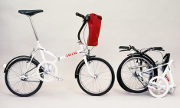 around the same time another original thinker, one Alex Moulton, created a prototype frame along similar lines to replace his original 'F' frame. Things must have been a bit frosty at first when Radnall and Moulton met to discuss it over a brew, but it became clear each had independently created the design. In any case, Moulton came up with a lighter, more upmarket design for his new bike. (Thanks to It's in the bag by Hadland and Pinkerton)
around the same time another original thinker, one Alex Moulton, created a prototype frame along similar lines to replace his original 'F' frame. Things must have been a bit frosty at first when Radnall and Moulton met to discuss it over a brew, but it became clear each had independently created the design. In any case, Moulton came up with a lighter, more upmarket design for his new bike. (Thanks to It's in the bag by Hadland and Pinkerton)
The frame shape isn't the only link with Moulton. It's got Moulton-sized wheels, Moulton-style chainset and chainguard and Moulton-style quick releases for the seat post and steering.
Various of the other parts are very distinctive, Radnall-made items. These include the levers (which bear the Radnall logo), the unusual-looking brake calipers and the lamp brackets. The pedals are of Japanese 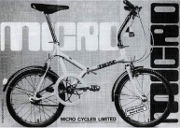 manufacture, and they too are distinctive with their dinky-looking white rubbers with bright red trim. The right pedal can be folded out of the way after hand unscrewing it from the crank.
manufacture, and they too are distinctive with their dinky-looking white rubbers with bright red trim. The right pedal can be folded out of the way after hand unscrewing it from the crank.
This Micro currently wears MKS alloy folding pedals; these are a bit lighter and a lot more practical than those wonderful, daggy originals. This and the other changes I have made to the bike (again, more anon) don't greatly change its appearance, yet add greatly to its usefulness (I have kept all the original parts).
The fold
Folding and unfolding is generally easy and quick. The Micro in standard condition has cables routed through the frame to the rear for the caliper brake and Sturmey Archer three speed hub. Those cables can make folding the bike 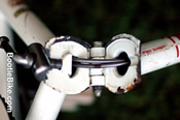 just a touch awkward, as they get pushed around and stretched where they pass through the frame joint. The cables really do get a hard time, which is probably why they have metal shielding.
just a touch awkward, as they get pushed around and stretched where they pass through the frame joint. The cables really do get a hard time, which is probably why they have metal shielding.
The Raleigh RSW III-style swan neck handlebars don't fold or slide down – you're supposed to rotate them 90° or remove them altogether for maximum compactness. Ditto the seat post, which at least slides down a fair way. Publicity material shows the three chunks – seatpost, handlebars and everything else – tucked into a big red bag held aloft by a fashionably-dressed woman with a Lindy Chamberlain hairstyle. I've found that in practice it's not necessary to lower the bars or seat. Just folding it and rotating the bars makes it small enough for the most crowded train.
Built to last – not
Unfortunately, those stashed parts may soon be all that remains of the Micro, as the rapidly deteriorating original finish is allowing anything ferrous to return to its natural state. The whole bike looks tatty – sure, it's old and neglected, but it's tattier than it should be, and getting worse even now. What passes for the white paint on the bike seems to come off in chips, at the slightest provocation, and I don't think the micron-thin matt black paint on the various cycle parts was ever meant to resist rust. (It seems this is not the first complaint about the paint quality.)
The rampant ferrousness of the Micro is not the only issue threatening its longevity,  as yours truly, in the course of duty, inadvertently tested the frame to it's near destruction.
as yours truly, in the course of duty, inadvertently tested the frame to it's near destruction.  A quiet squeak that became not-so-quiet turned out to be a crack along the edge of the weld at the join of the forward main tube and hinge. It seems to me that the high temperatures caused by the welding have weakened the tubing where strength is most needed. (Is it any wonder that steel frames are traditionally brazed rather than welded?) Anyway, some emergency repairs and the addition of a small reinforcing fillet and the squeak is no more, at least for now. Watch this space.
A quiet squeak that became not-so-quiet turned out to be a crack along the edge of the weld at the join of the forward main tube and hinge. It seems to me that the high temperatures caused by the welding have weakened the tubing where strength is most needed. (Is it any wonder that steel frames are traditionally brazed rather than welded?) Anyway, some emergency repairs and the addition of a small reinforcing fillet and the squeak is no more, at least for now. Watch this space.
On the road
Upon first seeing the Micro one wonders if it really is meant to be ridden by an adult. With that minimalist frame, the 349 wheels and the outrageously short wheelbase (note how the chainwheel overlaps the rear wheel, and the short chain run), it appears to the casual eye as nothing more than a teenager's bmx bike. Nevertheless, it fits an adult (with a bit of mental and physical adjustment) and can indeed be ridden. One is always conscious of the ride quality, or lack thereof, but keep in mind the Micro's intended purpose in life and you can forgive it.
The ultra short wheelbase does have effects beyond the bumpy ride, not least the tendency of the front wheel to lift on hills, and the possibility of the whole thing flipping over backwards. Radnall was obviously aware of this and set the handlebars fairly low. The lowness seems a bit odd at first for a bike with no sporting pretensions, but the reason becomes apparent when one raises the bars. The Plimsoll line on the stem seems to be there to tell you something.
Tiny fault – Big problems
Once you get over the initial shock of being perched on (what seems like) a kid's bike, you notice the rapidfire response, manoeuvrability and the low gearing. However, it isn't long before one finds a fault so petty, yet 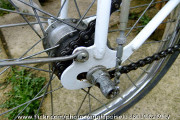 so serious it can't be overlooked. The tiny control chain protruding from the rear axle (which is no longer fitted on the featured bike) is frequently in the path of the rider's right foot. It badly affects the riding, and it seems the Design Council folk who were so impressed by the Micro hadn't actually ridden it.
so serious it can't be overlooked. The tiny control chain protruding from the rear axle (which is no longer fitted on the featured bike) is frequently in the path of the rider's right foot. It badly affects the riding, and it seems the Design Council folk who were so impressed by the Micro hadn't actually ridden it.
I overcame the problem by fitting a hub without a protruding chain, so there is nothing to bump one's foot against. The hub in question is the very nifty Fichtel & Sachs Duomatic two speed with coaster brake. Instead of using a trigger control (which connects with the little chain protruding from the rear axle), the rider shifts gears by back pedalling slightly. This method of gearchanging is very quick and it becomes quite intuitive.
The change achieved its purpose and more besides, so much so that I wonder why a two speed like this wasn't offered in the first place. The built-in brake reduces maintenance, and folding is easier, as there are no longer any cables passing throught the frame join on the way to the rear. One no longer deals with the clunky, Sturmey Archer trigger control, and the bike is much more fun to ride. Truly a case of 'less is more'.
Production and development
I do wonder how many of the Micros were made. Hadland and Pinkerton cite a total of over 5000, which, over say five years, doesn't sound like much. However, the evidence on this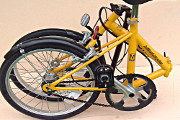 bike suggests an even lower number. Judge for yourself: It was sold in 1978 at the earliest (it bears a 1978 Design Council award sticker), yet the original Sturmey Archer hub is dated 1976. And the frame number is 1091. What do you think?
bike suggests an even lower number. Judge for yourself: It was sold in 1978 at the earliest (it bears a 1978 Design Council award sticker), yet the original Sturmey Archer hub is dated 1976. And the frame number is 1091. What do you think?
Production of the original Micro lasted until around 1980, and to my knowledge without any significant changes. But that was not the end. The design was resurrected in the 1990s, with changes to address the more serious shortcomings and make the bike lighter and more convenient. The changes included increasing the wheelbase by lengthening rear triangle (no more clashing of heel and indicator chain, fewer wheelies), handlebars that folded down, and the use of alloy components instead of steel. More recently the slightly larger 'fold it' version, with 20" wheels, has also been available. Click here for photos of other examples the original Micro and its successors. (Thanks to It's in the bag)
Minutiae
Wheelbase: 79cm (31")
Weight: 11 kg (with Duomatic)
Wheels: 349 x 37 (F frame Moulton size)
Materials: Steel frame and parts. No alloy
Components: Many of the small bits are Radnall-made, including those brake calipers. The chainset is generic Nicklin with Moulton chainguard. Rigida chrome rims with 'rumble strip' braking surface for some detectable braking power in the wet and irritating noise the rest of the time. Sturmey Archer front hub, AW rear. Japanese rubber block pedals, right semi-detachable. Moulton-type quick releases for seat post and handlebars.
Spousal Ridicule Index: Very high

